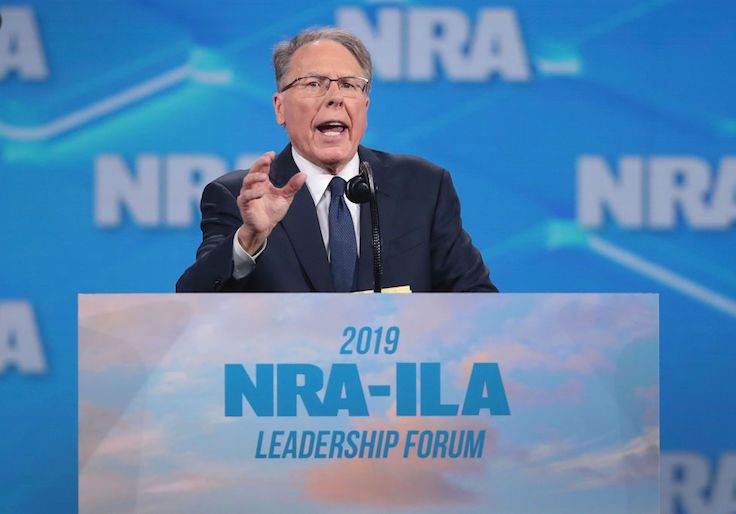The National Rifle Association cut salaries and programs in 2019 to keep up with a drop in membership and soaring legal bills.
Membership dues to the NRA fell more than $57 million—or 33 percent—between 2018 and 2019, according to a copy of the group's latest annual report obtained by the Washington Free Beacon. While contributions remained steady, the group was unable to make up the gap in funding from other sources and saw overall revenue fall by about the same amount. In response to the falling revenue, the group cut expenses across the board by more than $73 million—or 17 percent—with legislative programs and public affairs taking the largest hits even. Legal costs rose by 52 percent to more than $33 million.
Like many political advocacy groups, the NRA's membership and fundraising tend to fluctuate based on election years. Membership dues in 2019, however, were also down more than $15 million—or 11 percent—from the previous non-election year of 2017. The group's expenses also fell about 7 percent compared to 2017. The group still ran a $16 million deficit in 2019 before contributions with donor restrictions are factored in.
Amy Hunter, an NRA spokeswoman, said the 2019 annual report does not reflect the current financial state of the NRA. She said the group added 100,000 new members in August alone amid historic gun sales in 2020.
"Revenues and membership are skyrocketing," Hunter told the Washington Free Beacon. "The NRA is enjoying historic growth from a record number of new gun owners."
While the NRA has remained a potent force in the 2020 election, the 2019 downturn in membership may have hampered its ability to spend at the same rate it did in 2016. The group has seen new members join its ranks in 2020 despite the coronavirus pandemic and the New York attorney general's attempt to dissolve the group over financial-impropriety accusations. The group has kept its promise to spend tens of millions on behalf of President Donald Trump and has managed to outspend the leading gun-control groups. The $31 million spent between its PAC and super PAC to bolster Republicans is still well below its $52 million effort in 2016. Hunter said diminished spending has not hampered the group's campaign "mobilizing millions of voters."
Some critics blamed falling dues on accusations of financial impropriety lodged against executive vice president Wayne LaPierre and other top NRA executives. Rob Pincus, a lifetime NRA member and board member for Save the Second, which advocates for internal NRA policy changes, said the decline may go deeper than the typical election-cycle fluctuation.
"The drop in membership revenue is directly related to Wayne LaPierre's refusal to step down during the current crisis, the responsibility for which lies on his desk," he told the Free Beacon.
Hunter said LaPierre deserves "great credit for reducing costs and managing the NRA through a financial and health crisis that has destroyed so many businesses and charitable organizations," and the gun-rights organization's financial picture is now bright.
"We made some tough decisions to ensure the long-term viability of the NRA and its advocacy," she said.
Pincus said the drop in membership dues "should be a concern for all members." The NRA has reported up to six million members in previous years but the number fluctuates as shorter-term memberships expire or new members sign up. Pincus, who has been a vocal critic of LaPierre and other executives since the internal turmoil began in 2019, said an audit proposal he made was met with support from several board members.
Pincus introduced a measure to audit the gun-rights group's membership rolls and provide a report on how many members the group has at each level at a scaled-down meeting of members in Tucson, Ariz., this month.
"The NRA's perceived power and influence in American politics and the national conversation about guns is directly related to the real number of members the organization has, and percentage of American gun owners who are active members," he said. "Even if the numbers are falling, we need to know what those numbers are."
Despite the membership drop in 2019, the NRA remained a sizable organization—the largest gun group in the country. It reported more than $342 million in assets in 2019 spread across six different arms. That's $15 million more than in 2018.
